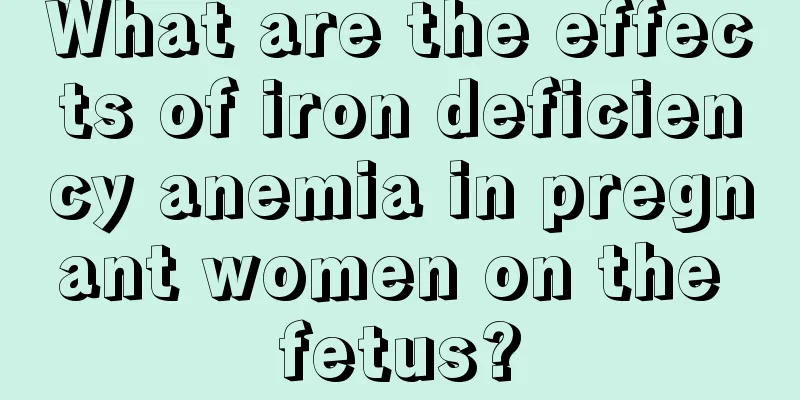What are the effects of iron deficiency anemia in pregnant women on the fetus?

|
Pregnant women will be very worried if they have iron deficiency anemia, but they dare not take some medicine casually, for fear that it will have a bad effect on the fetus in their belly. Generally speaking, iron deficiency anemia will affect the fetus, and it must be treated as soon as it occurs. In terms of diet, you can also eat more foods that have blood-enriching effects, which can also improve your symptoms well. Such as heavy menstrual flow in women, black stools/bloody stools/abdominal discomfort caused by gastrointestinal ulcers/tumors/hemorrhoids, abdominal pain/changes in stool characteristics caused by intestinal parasitic infections, weight loss due to tumor diseases, hemoglobinuria due to intravascular hemolysis, etc. Anemia manifestations Fatigue, tiredness, dizziness, headache, blurred vision, tinnitus, palpitations, shortness of breath, poor appetite; paleness, increased heart rate. Symptoms of tissue iron deficiency Mental and behavioral abnormalities, such as irritability, anger, inattention, and pica; decreased physical strength and endurance; susceptibility to infection; slow growth and development in children, and mental retardation; stomatitis, glossitis, atrophy of the tongue papillae, chapped corners of the mouth, and dysphagia; dry and falling hair; dry and wrinkled skin; lack of luster in the nails and being brittle and easy to crack. In severe cases, the nails may become flat or even concave and spoon-shaped (knee nails). It should be differentiated from the following microcytic anemia. 1. Sideroblastic anemia: Anemia caused by impaired red blood cell iron utilization due to genetic or unknown causes. It manifests as microcytic anemia, but the serum ferritin concentration is increased, the number of hemosiderin granules in the bone marrow increases, the number of sideroblasts increases, and ring sideroblasts appear. Serum iron and iron saturation increase, and total iron binding capacity is not low. 2. Thalassemia: There is a family history. There are signs of hemolysis. Many target cells can be seen in the blood smear. Increased fetal hemoglobin or hemoglobin A2. Serum ferritin, bone marrow stainable iron, serum iron and iron saturation are not low and are often increased. 3. Anemia of chronic disease: anemia due to abnormal iron metabolism caused by chronic inflammation, infection, or tumor. The anemia is microcytic. Iron storage (serum ferritin and bone marrow granular hemosiderin) is increased. Serum iron, serum iron saturation, and total iron binding capacity were decreased. Transferrin deficiency: autosomal recessive (congenital) or secondary to severe liver disease or tumor (acquired). It manifests as microcytic hypochromic anemia. Serum iron, total iron binding capacity, serum ferritin and bone marrow hemosiderin were significantly decreased. Congenital, occurs in young children, accompanied by developmental abnormalities and multiple organ dysfunction. Acquired, with manifestations of primary disease. [1][2] |
<<: Is it scientific to have a 100-day confinement period?
>>: Why is the leucorrhea as elastic as jelly?
Recommend
White tongue during early pregnancy
In the early stages of pregnancy, due to the incr...
What causes vomiting during late pregnancy?
There are many normal pregnancy reactions in wome...
Perineum fissure pictures
Why is it that every time I have sex, there is a ...
Why do nipples crack?
It is the first time for them to breastfeed their...
Is it okay for women to wear belly-control underwear?
For white-collar workers who sit for long periods...
I'm pregnant and it hurts, what's going on?
If a female friend experiences pain in the lower ...
What to do if your hands and feet are swollen at 39 weeks of pregnancy
Although women who are 39 weeks pregnant are alre...
Age at first menstruation
The first time a woman has her first period is of...
Eighth day of menstruation with brown discharge
The fluid that flows out of the lower body after ...
comScore: Data shows that Americans now spend much more time on apps than on desktop applications
There is no doubt that we now live in a world ful...
What should pregnant women do if they have thick subcutaneous fat?
For many pregnant women, for the health of the ba...
What medicine should I use for the odor after menstruation
Women's lower body must be cleaned every day,...
What to do if one side of the vulva is swollen
A woman's private parts must be attacked by m...
What are the dangers of anemia to pregnant women?
Anemia is quite harmful to pregnant women, becaus...









